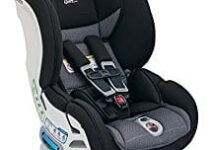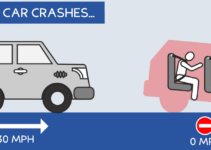Have you ever grabbed a gallon of milk from the grocery store, and poured yourself a glass when you get home, only to be overwhelmed by the putrid smell or chunky texture? It doesn’t take long for you to realize you didn’t look at the sell-by or expiration date on the jug. You had unknowingly picked up an expired gallon of milk. If you’re anything like me, down the drain goes the bad milk as it is unusable and not fit for human consumption.
You may be wondering what milk and car seats have in common. More than you think! They both have expiration dates or use-by dates if you want to think of it in that respect. Because they are safety devices, car seats have a period of use that starts at the date of manufacturing and ends at their expiration date. Knowing, understanding, and adhering to a car seat’s expiration date is extremely important to the safe use of the seat and the safety of your child. Many parents don’t know that car seats expire, or understand why they do. So let’s dive into all you need to know about car seat expiration dates!
Table of Contents
Why Do Car Seats Expire?
I want you to take a moment to look around you and think about the items that you use in your home. Nothing lasts forever. That cell phone in your hand is mostly less than two years old. We tend to upgrade the devices around our home much more frequently than needed because we want the newest and latest technology. Car seats last longer than your cell phone technology and yet many caregivers fight the expiration date on their car seats. Let’s look at some of the reasons manufacturers assign expiration dates to their car seats.
Environmental Factors
Many environmental factors contribute to the need for a car seat to have an expiration date. Drinks, food, dirt, debris, cleaners (or inappropriate cleaners), and other environmental contaminants can cause a car seat to degrade over time and affect the seat’s effectiveness in a crash.
Wear and Tear
Just like other items in your home (think about your washer and dryer or other appliances), car seats are not made to last forever, and used almost every day, have the potential to inflict wear and tear on the seat. In addition, parts of your seat could become lost over time or even damaged from incorrect installations-all contributing to the wear on the car seat.
Updated Instructions/Labels Legibility/Change in Regulatory Requirements
The field of child passenger safety is consistently and constantly changing. Safety devices such as car seats are subject to stringent performance standards. While car seat manufacturers are businesses putting out new products to meet the need of consumers, they are also releasing new seats to adhere to updated or new car seat safety standards and requirements. When updates are made to FMVSS 213 or other regulatory documents, this may change how instructions and labels can look or be worded. These regulatory changes are not retroactive, therefore car seats that are beyond their expiration or use life may not have the same protective advantages. Additionally, over time, instructions or labels may not be consistent with new standards or be legible for a caregiver to read. Manufacturers can also choose to make voluntary improvements to their car seats that expired car seats will not offer.
Enhancements in Technology
Car seat manufacturers are always looking to make improvements and enhancements to the design, testing, technology, materials, and manufacturing to provide better safety and protection for the child. Frequently, these advances are made in the seat’s performance, comfort, convenience, and ease of use.
Recalls and Damage
Expiration dates allow for car seats that have been recalled or damaged to be moved out of circulation and to discourage the use of second-hand car seats. Car seat expiration dates also allow for older car seats to be phased out of circulation so that newer car seats with better safety, technology, and the latest regulatory requirements will become more prevalent. If a seat is involved in a crash, this can significantly affect its length of useful life. Across all manufacturers, any moderate or severe crash requires the replacement of a car seat. While even minor crashes can cause some damage, the replacement policy is dictated by the manufacturer. Crash damage is another reason for discouraging secondhand seat use as the caregiver must be fully aware of the entire seat history including any crashes.
Are Manufacturers Required to Give a Car Seat Expiration Date?
Car seat manufacturers are not required to label an expiration date on their seats per the labeling requirements listed in FMVSS 213. They are, however, required to provide the date of manufacture along with other information on the label. As NHTSA explains, manufacturers provide these expiration dates for their car seats to provide consumers with guidance on the expected useful life of a particular seat. While the average car seat expiration dates are anywhere from 6-8 years, some car seats will have a 10-year expiration. It is always advised for caregivers to check the label on their car seat, seat manual, or contact the seat manufacturer to obtain this information.
How Long Is a Car Seat Good For? How Do I Find My Car Seat’s Expiration Date?
Typically, car seats expire anywhere from 6 to 10 years depending upon the manufacturer and the type of seat. Many car seats do include an expiration date on their manufacturing label, though they are only required to provide a date of manufacture. If your date of expiration is not on this label, examine your manual or contact the manufacturer. Below I have provided some examples of various manufacturer labels and locations to give you an idea of where to look on your specific seat. However, this information is for learning purposes only and should not take priority over the information contained in your manual, on your seat, or that from the manufacturer. Always confirm your car seat expiration date with information obtained from your specific seat.
Example #1: Evenflo SureRide/Titan 65 Convertible Car Seat
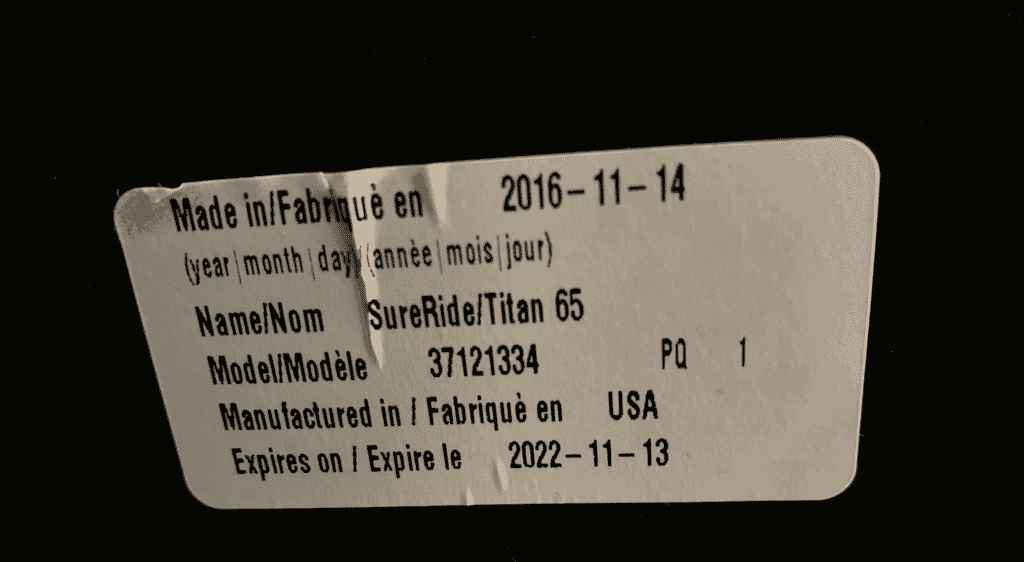
This label shows a label for an Evenflo SureRide/Titan 65. On this label, the manufacturer has supplied the manufacture date as well as the expiration. This seat was manufactured in November 2016 and expires in November 2022. This label was located on the back of the car seat and to the right of the splitter plate.
Example #2: Britax Marathon ClickTight Convertible Car Seat
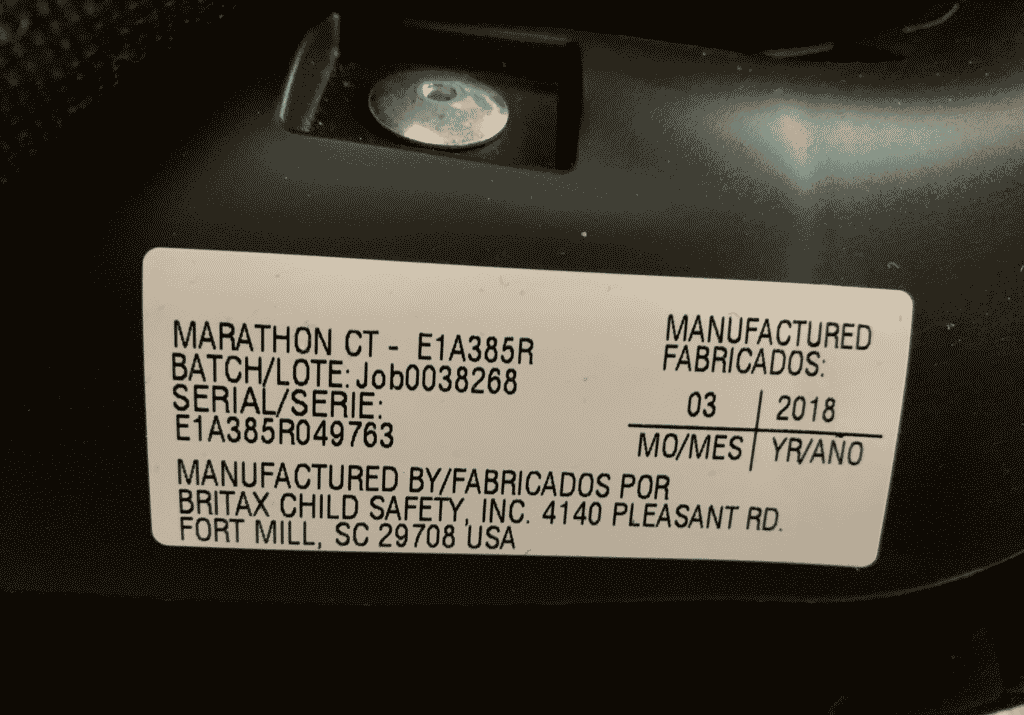
This label belongs to a Britax Marathon ClickTight that was manufactured in March 2018. The expiration label is not included on this sticker and therefore, the expiration information would need to be obtained from the seat’s manual or manufacturer. For your information, this seat will expire in March 2028. This label was a bit more difficult to find. It was located on the front part of the seat. You must move the bottom part of the seat pad up slightly to be able to view the label.
Example #3: Graco Turbo Highback Booster Seat
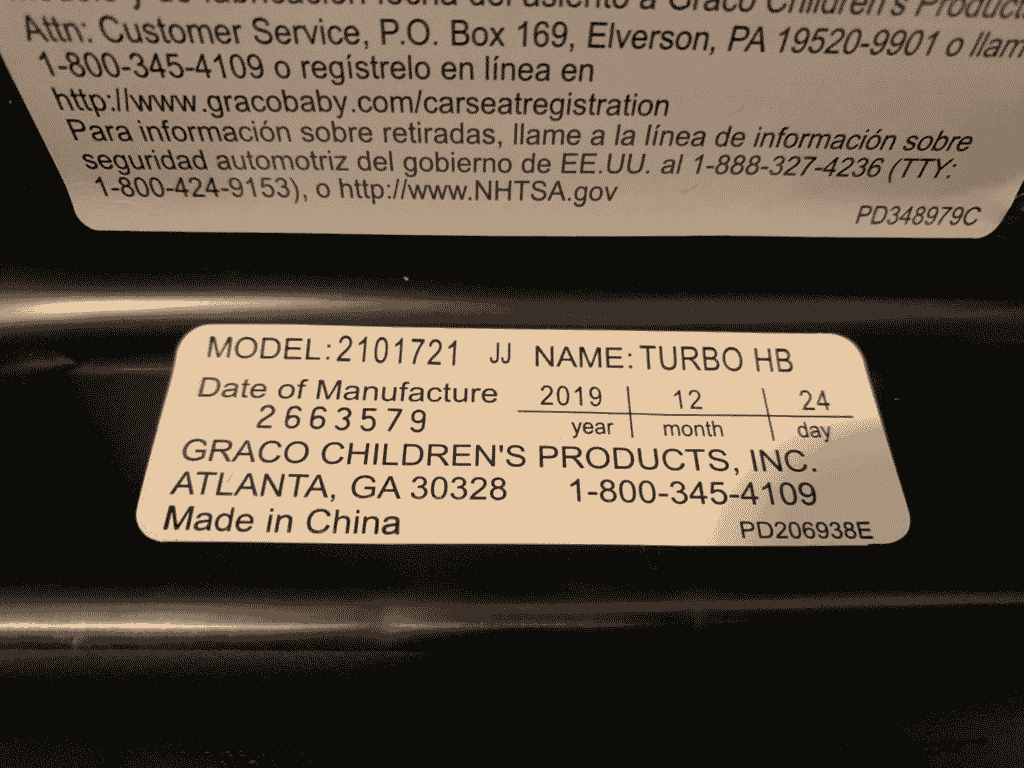
This label belongs to a Graco Turbo Highback booster. Again, we have a seat that only supplies the manufacture date on this label. Be sure to confirm the expiration date with the manual or manufacturer. This particular booster expires in December 2029. I found this label by turning the booster over and locating it on the bottom of the seat.
Example #4: Chicco KeyFit Infant Car Seat
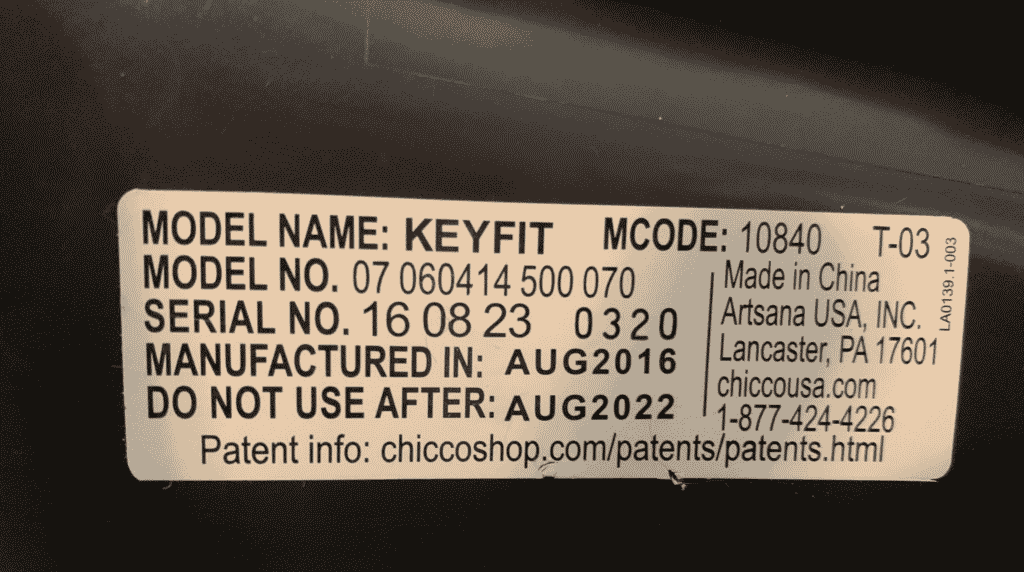
This label belongs to a Chicco KeyFit carrier that was manufactured in August 2016 and expires in August 2022. For this seat, the expiration date was given to us by instructing us not to use the seat after August 2022. This label is found on the underside of the carrier.
Example #5: Craco Contender 65 Car Seat
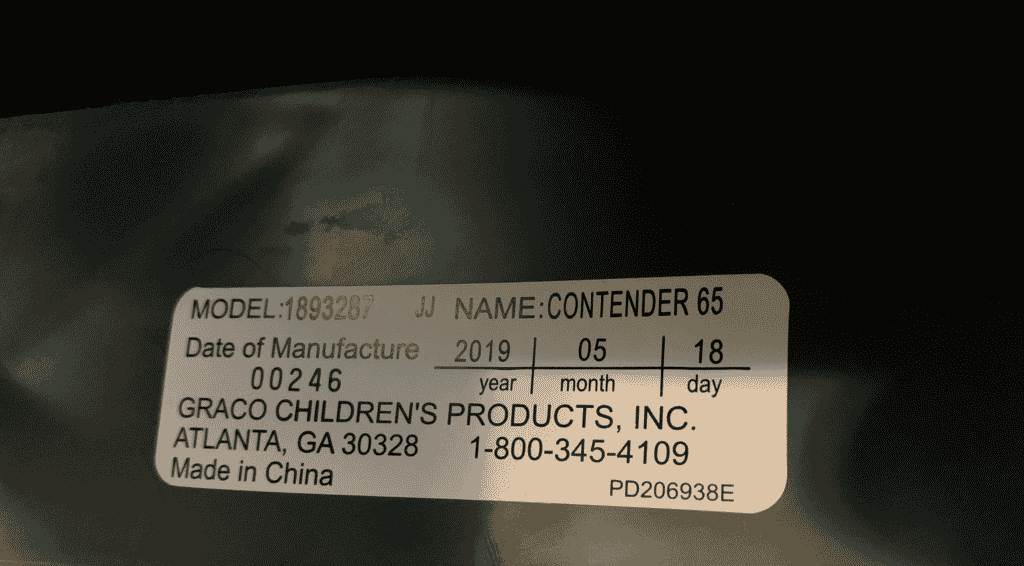
This Graco Contender was manufactured in May 2019 but the expiration date is not provided. Again, always verify the expiration date from your manual or with the manufacturer. This label was located on the back of the seat near the headrest. This seat has a 7-year expiration date and therefore expires in 2026.
When the Expiration Date is Etched into the Shell
Another type of label that exists is one that is etched into the plastic shell of the seat. These can be relatively hard to spot as they tend to blend into the color of the shell. If you cannot find a label adhered to the shell, try looking for this information etched into the plastic instead.
Can You Use An Expired Car Seat?
The shortest answer is that you shouldn’t use an expired car seat. In some states, it could be considered illegal as you are not using the car seat as indicated by the manufacturer. In practice as a CPST, I would never recommend a caregiver to use an expired car seat. However, I do understand that situations such as cost and other factors may prevent a family from being able to afford a new seat. I would discuss with the caregiver why car seats expire as noted previously in this article. I would work with the caregiver to find a safer and more realistic option for them, such as the potential of using a secondhand seat or a program that could provide a car seat for them. Just as with second-hand car seats, CPSTs cannot certify or verify an expired seat is safe to use. Ultimately, it is best practice to not use a seat once it is expired, and falls upon the caregiver to make the final informed decision.
What to Do With an Expired Car Seat
An expired seat should be disposed of in a manner that makes it unable to be reused by other caregivers. If your state offers a car seat recycling program, please take part, and drop your seat off to be recycled. Otherwise, before disposing of, remove the padding and all soft goods, cut the harnesses, and label the plastic shell with a permanent marker stating, “Expired. Do not use.” Another measure many caregivers choose to do is to place all soft goods in a separate bag or trash can than the shell to prevent others from reassembling the seat.
When to Stop Using a Car Seat Even if it Hasn’t Expired
There are a few reasons you may need to stop using your car seat, even if it hasn’t passed its expiration date. Some reasons to stop using a car seat (but not limited to) include if the car seat has been in an accident, is a used car seat with an unclear or unsafe background, the seat is no longer in good working condition, or has been recalled. These situations are quite individualized, so let’s look more closely at these situations.
When your car seat has been in a crash (whether occupied by a child or not), it is important to know the seat’s crash/replacement policy. If you have had a moderate or severe crash, all car seat manufacturers require the replacement of the car seat. However, for a minor crash, the replacement will depend upon if the manufacturer follows NHTSA’s minor crash replacement criteria or if they still require replacement after a minor crash. If you are unsure if your incident could be considered a crash at all, I recommend you contact the manufacturer for further guidance. For some caregivers, replacing a seat seems silly, however, even if there is no visible damage to a seat, it is unclear how a seat would perform in a subsequent crash.
If you are using a secondhand seat, it is extremely important that you know the car seat’s prior history and you obtained the seat from a trustworthy source. I never recommend purchasing or using a used seat from a stranger. Remember, you are entrusting this person’s proper usage and treatment of the seat with your child’s safety in a crash. In addition to acquiring a car seat from a trusted individual, the seat must also meet this criterion: has been cleaned appropriately with approved cleaners, never been in a crash, traveled appropriately on an airline, has all necessary labels, contains all pieces and is in good working order, is not expired and has not been recalled (or the recall has been remedied). If you can confirm and trust the individual giving you this information, then the seat could be a strong option. Remember that a CPST will never certify or verify that a seat is safe to use. It is completely at your discretion as the caregiver to consider using a secondhand seat.
For whatever reason, if your car seat has broken parts, visible damage, or isn’t working as expected, you need to stop using the seat until the issue can be rectified. This also goes for any active recalls on your seat. If your seat has been recalled, follow the directions of the manufacturer. In some instances, a manufacturer may request that you stop using the seat until they can deliver or develop a remedy for you. In some recalls, manufacturers will allow continued use of the seat as it may pertain to other issues with the seat and not necessarily the safety performance of the seat.
Last Thoughts
Car seat expiration dates provide important information about your car seat and aren’t developed arbitrarily. These dates help to ensure that consumers are using car seats that are up to date with the most recent technology enhancements and regulatory requirements. Car seat expiration dates also assist in removing older car seats from circulation that may not be in the best condition due to recalls, damage, environmental factors, or general wear and tear. It is best to respect the expiration dates assigned by the manufacturer and replace the seat when the date has been reached. Doing so assists in keeping your child the safest they can be in the car seat.


